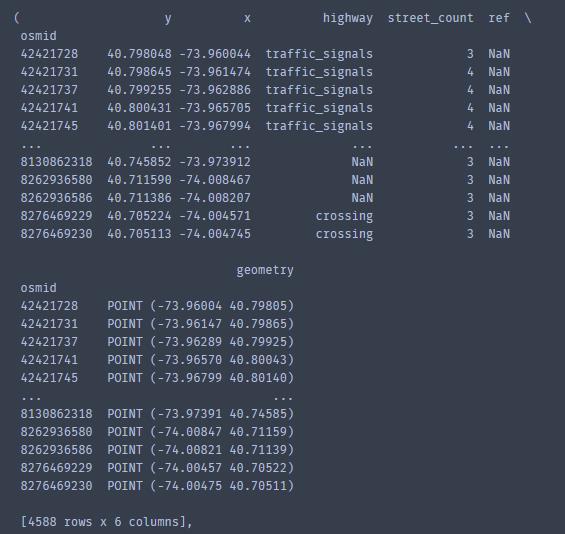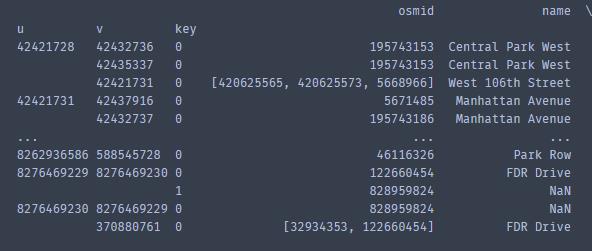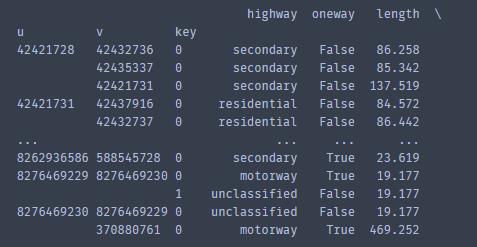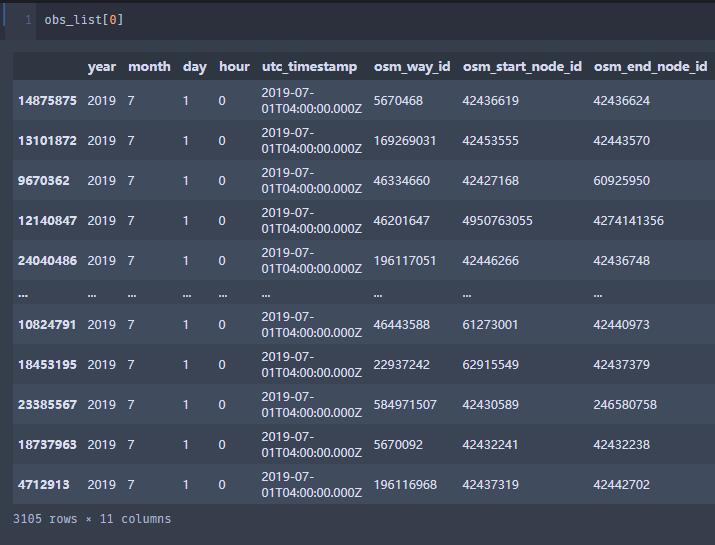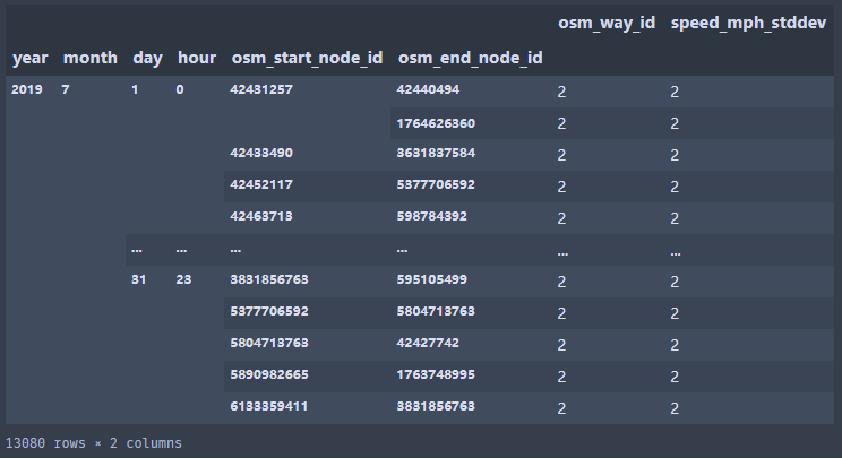pytorch 笔记: 复现论文 Stochastic Weight Completion for Road Networks using Graph Convolutional Networks(代
Posted UQI-LIUWJ
tags:
篇首语:本文由小常识网(cha138.com)小编为大家整理,主要介绍了pytorch 笔记: 复现论文 Stochastic Weight Completion for Road Networks using Graph Convolutional Networks(代相关的知识,希望对你有一定的参考价值。
1 理论部分
2 导入库
import torch
import torch.nn.functional as F
import numpy as np
import pandas as pd
import os
from torch_geometric.data import Data, DataLoader
from torch_geometric.utils import normalized_cut
from torch_geometric.nn import (ChebConv, graclus, GCNConv,
max_pool, max_pool_x, global_mean_pool)
from toolz.curried import *
3 数据集处理
数据集来源是uber movement 以及纽约的osm 地图数据
Uber Movement: Let's find smarter ways forward, together.
np.random.seed(123)
torch.manual_seed(123)
uberdir = "D:/"
nykjuly = os.path.join(uberdir, "movement-speeds-hourly-new-york-2019-7.csv.zip")
device = torch.device('cuda' if torch.cuda.is_available() else 'cpu')
nodes, edges = load_gdfs("data/newyork/")
#There are 4588 nodes and 9893 edges in the road networks.
df = pd.read_csv(nykjuly)
#获取一个月的出行数据
df = attach_edgeid(nodes, edges, df)
#原来的shape:(25365815, 13)
#去掉了['segment_id','start_junction_id','end_junction_id']三列,加上了edge_id(表示这条边是edges里面的第edge_id条边】)
#同时只保留起止边和way_id都在edges里面的边
#去掉之后的shape:(2653457, 11),少了很多条出行记录
dG = edge_topology_from_edges(edges)
#相当于边变成点,如果原图两条边在一个点相交,那么转换之后的图中两个点有连边
#Construct edge topology from the `edges` (The graph with road segments as nodes).
n_test = 3 * 24
#一个月最后三天作为测试集,之前的是训练集
n_epochs = 5
batch_size = 1
obs, unobs = split_obs_unobs(df, ratio=0.9)
#obs——744个小时,每一个小时90%的数据(DataFrame)
#uobs——744个小时,每一个小时后10%的数据(DataFrame)
obs = [g for (_, g) in obs.groupby(['month', 'day', 'hour'])]
unobs = [g for (_, g) in unobs.groupby(['month', 'day', 'hour'])]
#obs——744个小时,每一个小时10%的数据(list)
#划分有观测点的数据和无观测点的数据(的ground truth)3.1 load_gdfs
导入地图数据,获得点集和边集
#导入地图数据 def load_gdfs(datadir: str) -> Tuple[GeoDataFrame, GeoDataFrame]: """ Load the nodes and edges GeoDataFrame from graphml saved by `save_graphml_from_places`. Usage: nodes, edges = load_gdfs("data/newyork/") """ G = ox.load_graphml(os.path.join(datadir, "graph.graphml")) #导入地图数据 nodes, edges = ox.graph_to_gdfs(G, nodes=True, edges=True) # Convert a MultiDiGraph to node and/or edge GeoDataFrames. nodes['osmid'] = nodes.index.values ## the centroid coordindates of road segments points = edges.geometry.to_crs(epsg=3395).centroid #切换crs投影坐标,同时point表示边的质心 coords = pipe(points.map(lambda p: (p.x, p.y)).values, map(list), list, np.array) #将质心提取为ndarray的二维数组,每一个元素是质心的横纵坐标(变成ndarray的原因是方便找到每一列的min) coords = coords - coords.min(axis=0) #减去每一列的最小值 edges['coords'] = pipe(coords, map(tuple), list) #变回list,添加到coords这一列中 edges['osmid'] = edges.osmid.map(lambda x: x if isinstance(x, list) else [x]) u, v, _ = list(zip(*edges.index)) edges["u"] = u edges["v"] = v edges['id'] = np.arange(edges.shape[0]) edges.set_index('id', inplace=True, drop=False) #将id作为edges的活跃列(从0开始的数字) print(f"There are {nodes.shape[0]} nodes and {edges.shape[0]} edges in the road networks.") #导入多少列,出来多少列 return nodes, edges类似于simplified操作
同时将newyork里面的crs坐标系转换成uber使用的坐标系nodes几乎没动
edges加了一个coords条目,表示的是边的质心,同时edges的活跃列改为idnodes:
edges:
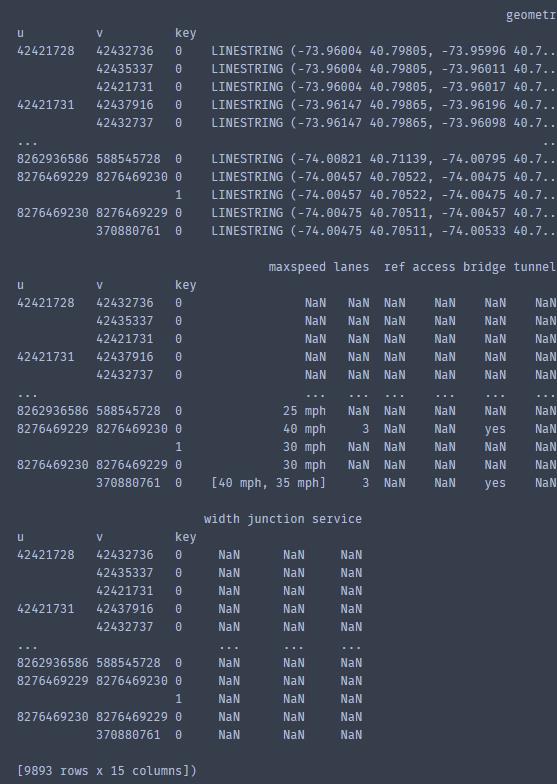
3.2 attach_edgeid
def attach_edgeid(nodes: GeoDataFrame, edges: GeoDataFrame, df: DataFrame) -> DataFrame: """ Filter and attaching uber one-month dataframe `df` a graph edge-id column, where the edge id is determined by (u, v, osmid) and only rows with edge id are kept. Usage: mh = attach_edgeid(nodes, edges, df) """ ## filtering by node ids sdf = df[df.osm_start_node_id.isin(nodes.osmid)&df.osm_end_node_id.isin(nodes.osmid)].copy() #start和end的点都在nodes里面的那些df行 ## dropping columns that will not be used sdf.drop(["segment_id", "start_junction_id", "end_junction_id"], axis=1, inplace=True) #丢弃这三行 edgeidmap = {(u, v): (osmid, edgeid) for (u, v, osmid, edgeid) in zip(edges.u, edges.v, edges.osmid, edges.id)} #对edges中的这四个属性,拼成一个字典 def getedgeid(u: int, v: int, osmid: int) -> int: """ Map the (u, v, osmid) tuple to the corresponding graph edge id and return -1 if there is no such edge in the graph. """ osmids, edgeid = get((u, v), edgeidmap, ([-1], -1)) #在edgeidmap中找(u,v),如果找到了,返回edgeid,否则,返回-1 return edgeid if osmid in osmids else -1 #如果osmids有这个osmid,那么成立,否则,不成立 edge_idx_cols = ['osm_start_node_id', 'osm_end_node_id', 'osm_way_id'] sdf['edgeid'] = sdf[edge_idx_cols].apply(lambda x: getedgeid(*x), axis=1) #首先,判断一条记录的起点和终点在不在edges的起止点上;其次,判断这条边的id在不在edges (u,v)对应的里面 sdf = sdf[sdf.edgeid >= 0]#留下存在的边 return sdf
3.3 edge_topology_from_edges
def edge_topology_from_edges(edges: GeoDataFrame) -> Graph: """ Construct edge topology from the `edges` (The graph with road segments as nodes). nx.line_graph() can construct the line graph directly from the original graph. Args edges: Geodataframe returned by load_gdfs. Returns G: A undirected graph whose node ids are edge ids in `edges`. """ triple = pd.concat([pd.DataFrame({'id': edges.id, 'u': edges.u, 'v': edges.v}), pd.DataFrame({'id': edges.id, 'u': edges.v, 'v': edges.u})], ignore_index=True) #一条边两个方向 pairs = [] for (_, g) in triple.groupby('u'): pairs += [(u, v) for u in g.id for v in g.id if u != v] for (_, g) in triple.groupby('v'): pairs += [(u, v) for u in g.id for v in g.id if u != v] #同时从一个点出发\\同时从一个点到达的边000 G = Graph() G.add_edges_from(pairs) #相当于边变成点,如果原图两条边在一个点相交,那么转换之后的图中两个点有连边 return G ''' 某一个的GROUPBY id u v 0 0 42421728 42432736 1 1 42421728 42435337 2 2 42421728 42421731 9898 5 42421728 42421731 12211 2318 42421728 42432736 12942 3049 42421728 42435337 '''
3.4 split_obs_unobs
def split_dataframe(df: DataFrame, ratio: Optional[float]=0.9) -> Tuple[DataFrame, DataFrame]: """ Split a dataframe into two parts along the row dimension by the given ratio. """ k = int(df.shape[0] * ratio) #要选择的行数 idx = np.random.permutation(df.shape[0]) #随机排列序号,划分为前k个和后面的部分 return df.iloc[idx[:k]], df.iloc[idx[k:]] def split_obs_unobs(df: DataFrame, ratio: Optional[float]=0.9) -> Tuple[DataFrame, DataFrame]: """ Split a one-month dataframe into observed and unobserved dataframes. Returns trn: Observations for a fraction of road segments. tst: Ground truth for road segments to be inferred. """ ## we should guarantee the results are invariant to calling order. np.random.seed(123) dfs = [split_dataframe(g, ratio=ratio) for (_, g) in df.groupby(['month', 'day', 'hour'])] trn = pd.concat(pipe(dfs, map(first), list)) tst = pd.concat(pipe(dfs, map(second), list)) return trn, tst
3.5 uber_movement数据集补充说明
| len(osm_ids.osm_way_id) | 33320 |
| len(osm_ids.osm_start_node_id) | 58601 |
| len(osm_ids.osm_end_node_id) | 58605 |
只有osm_way_id、osm_start_node_id、osm_end_node_id 加起来,才能唯一确定一个子路段
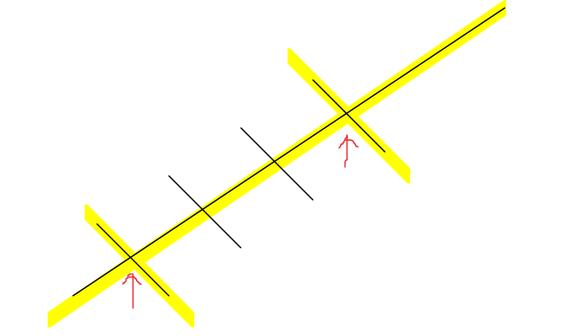
原因是因为,即使我们知道了osm_start_node_id、osm_end_node_id,但因为可能有地面、高架等不同的重叠路段,所以osm_way_id可能会不同(比如上图,黄颜色的是高架,黑线是地面道路。画红色箭头的是两个高架匝道,所以相同的osm_start_node_id、osm_end_node_id可能分别对应了地面和高架)
4 dataloader
trn_list = [get_data(dG, o, u) for (o, u) in zip(obs[:-n_test], unobs[:-n_test])]
tst_list = [get_data(dG, o, u) for (o, u) in zip(obs[-n_test:], unobs[-n_test:])]
#train_list的每一个元素都是torch_geometric的元素
#以第一个小时为例:Data(x=[9893, 1], edge_index=[2, 34637], y=[9893, 1])
#纽约一共有9893条边【edges.shape[0]】(在这里表示9893个点)
#这边的”边“相当于是,如果在纽约两条边有公共点,
#那么在我们的图上,边对应的点它们就相连
#trn_list和tst_list每一个元素是一个data数据
trn_loader = DataLoader(trn_list, batch_size=batch_size)
tst_loader = DataLoader(tst_list, batch_size=batch_size)4.1 get_data
def get_x(df: DataFrame, num_nodes: int) -> torch.FloatTensor: """ Get pytorch geometric input feature from observation dataframe. Inputs df: The observation dataframe with edgeid being attached. Returns x (num_nodes, num_features): Input feature tensor. """ node_obs = {u: [v] for (u, v) in zip(df.edgeid.values, df.speed_mph_mean.values)} ## (num_nodes, 1) #一个字典,键值是这一小时每个edge_id,value是这个edge_id对应的平均速度 return torch.FloatTensor([get(u, node_obs, [0]) for u in range(num_nodes)]) #训练集:[速度] 其他的都是[0] #测试集:[速度] 其他的都是[0] def get_data(G: Graph, obs: DataFrame, unobs: DataFrame) -> Data: #obs和unobs是某一个小时观测数据和未观测数据 edge_index = get_edge_index(G) #utils中的函数,将G的边集转换成Tensor,然后转置 x = get_x(obs, G.number_of_nodes()) y = get_x(unobs, G.number_of_nodes()) #训练集:速度 其他的都是0 #测试集:速度 其他的都是0 return Data(x=x, edge_index=edge_index, y=y)
5 model部分
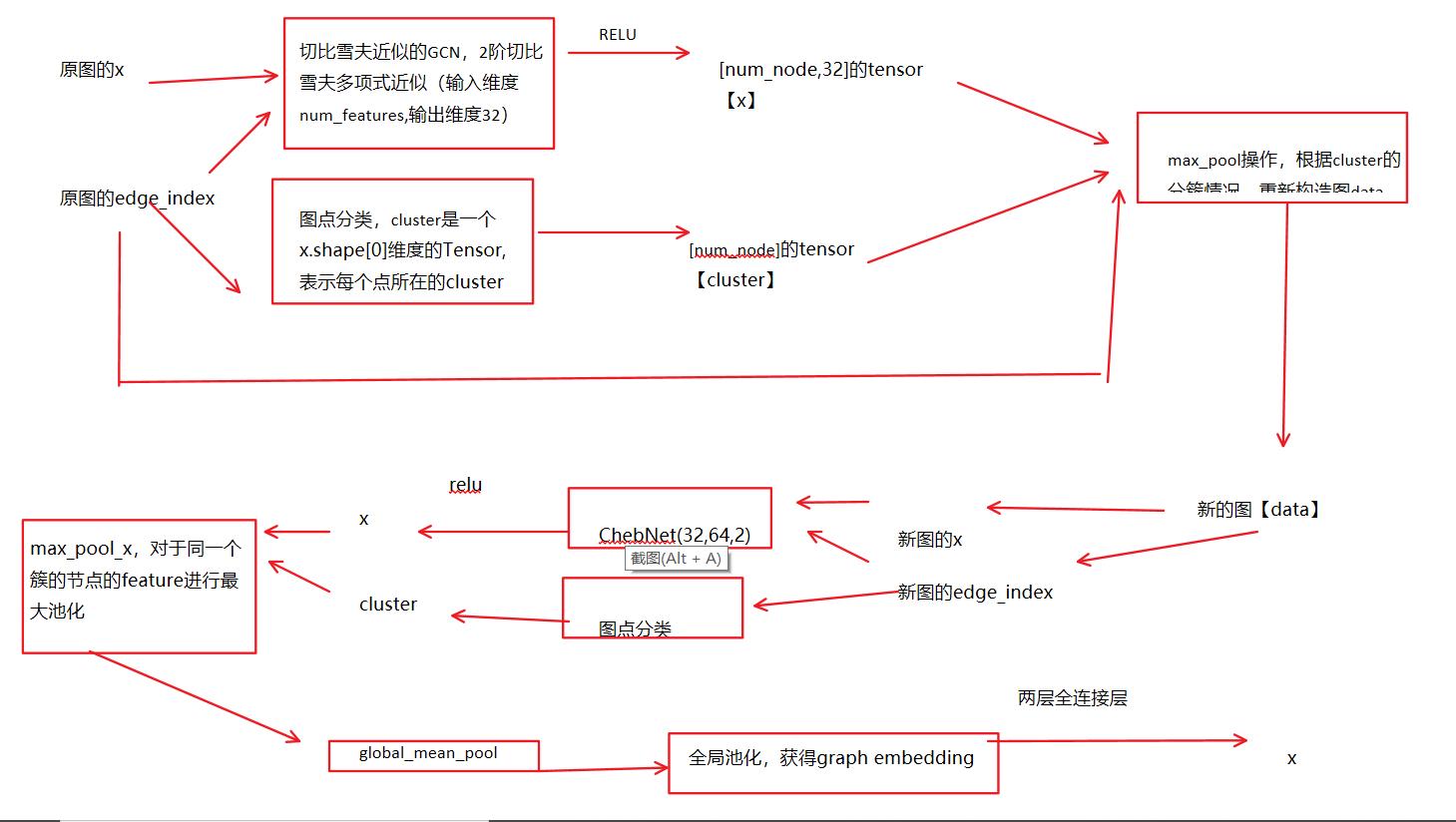
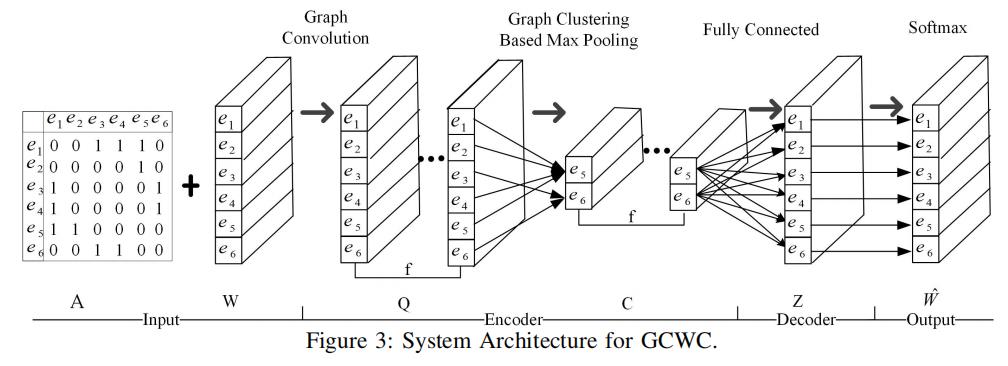
model = ChebNet(1, dG.number_of_nodes()).to(device)
optimizer = torch.optim.Adam(model.parameters(), lr=0.001)class ChebNet(torch.nn.Module):
def __init__(self, num_features, num_nodes):
super(ChebNet, self).__init__()
self.conv1 = ChebConv(num_features, 32, 2)
#切比雪夫近似的GCN,2阶切比雪夫多项式近似(输入维度num_features,输出维度32,2阶切比雪夫)
self.conv2 = ChebConv(32, 64, 2)
#切比雪夫近似的GCN,2阶切比雪夫多项式近似(输入维度32,输出维度64,2阶切比雪夫)
self.fc1 = torch.nn.Linear(64, 128)
self.fc2 = torch.nn.Linear(128, num_nodes)
#两层全连接层
def forward(self, data):
#以第一张图为例:
#data:Batch(x=[9893, 1], edge_index=[2, 34637], y=[9893, 1], batch=[9893], ptr=[2])
x = F.relu(self.conv1(data.x, data.edge_index))
#切比雪夫近似GCN+RELU
#x:torch.Size([9893, 1])
cluster = graclus(data.edge_index, num_nodes=x.shape[0])
#图点分类,cluster是一个x.shape[0]维度的Tensor,表示每个点所在的cluster
#cluster:torch.Size([9893])
data = max_pool(cluster, Data(x=x, batch=data.batch, edge_index=data.edge_index))
#data:Batch(x=[5870, 32], edge_index=[2, 22026], batch=[5870])
#max_pool操作,根据cluster的分簇情况,重新构造图data
x = F.relu(self.conv2(data.x, data.edge_index))
#x:torch.Size([5847, 64])
cluster = graclus(data.edge_index, num_nodes=x.shape[0])
#cluster:5847维的tensor
x, batch = max_pool_x(cluster, x, data.batch)
'''
x.shape,batch.shape
(torch.Size([3436, 64]), torch.Size([3436]))+
'''
x = global_mean_pool(x, batch)
#torch.Size([1, 64])
x = F.relu(self.fc1(x))
#torch.Size([1, 128])
x = F.dropout(x, training=self.training)
x = self.fc2(x)
#torch.Size([1, num_nodes])
return x6 训练模型
for epoch in range(n_epochs):
train(epoch, optimizer, trn_loader, model, device)def train(epoch, optimizer, train_loader, model, device):
model.train()
losses = []
for data in train_loader:
data = data.to(device)
xhat = model(data)#预测的各个点的速度
## -> (batch_size, num_nodes)
x = data.x.reshape(xhat.shape)
nz = x > 0#保留观测集的那些点
loss = F.mse_loss(xhat[nz], x[nz], reduction='sum') / nz.sum().item()
optimizer.zero_grad()
loss.backward()
optimizer.step()
#老三部曲
losses.append(loss.item())
print(f"Epoch is {epoch}, Training Loss is {np.mean(losses):.5f}")
'''
Epoch is 0, Training Loss is 55.03807
Epoch is 1, Training Loss is 29.84954
Epoch is 2, Training Loss is 21.36361
Epoch is 3, Training Loss is 19.08718
Epoch is 4, Training Loss is 18.11195
Epoch is 5, Training Loss is 18.60411
Epoch is 6, Training Loss is 17.49593
Epoch is 7, Training Loss is 17.83597
Epoch is 8, Training Loss is 17.09360
Epoch is 9, Training Loss is 17.26834
Epoch is 10, Training Loss is 17.15905
Epoch is 11, Training Loss is 16.93761
Epoch is 12, Training Loss is 16.54925
Epoch is 13, Training Loss is 16.65559
Epoch is 14, Training Loss is 16.71426
Wall time: 12min 2s
'''以上是关于pytorch 笔记: 复现论文 Stochastic Weight Completion for Road Networks using Graph Convolutional Networks(代的主要内容,如果未能解决你的问题,请参考以下文章
